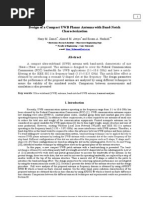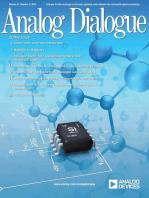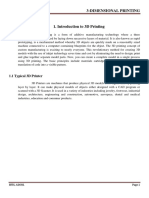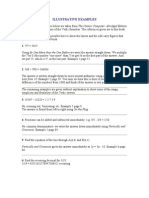Transmission Line Model:: Design of Microstrip Patch Antenna For 5G Applications
Uploaded by
wasim.Transmission Line Model:: Design of Microstrip Patch Antenna For 5G Applications
Uploaded by
wasim.Design Of Microstrip Patch Antenna For 5G Applications
Transmission Line Model:
This model represents the microstrip antenna by two slots of width W and height h, separated
by a transmission line of length L. The microstrip is essentially a non homogeneous line of
two dielectrics, typically the substrate and air.
Transmission Line Model
Hence, as seen from Figure, most of the electric field lines reside in the substrate and parts of
some lines in air. As a result, this transmission line cannot support pure transverse-electric-
magnetic (TEM) mode of transmission, since the phase velocities would be different in the
air and the substrate. Instead, the dominant mode of propagation would be the quasi-TEM
mode. Hence, an effective dielectric constant (𝜀𝑟𝑒𝑓𝑓 ) must be obtained in order to account for
the fringing and the wave propagation in the line. The value of 𝜀𝑟𝑒𝑓𝑓 is slightly less then 𝜀𝑟
because the fringing fields around the periphery of the patch are not confined in the dielectric
substrate but are also spread in the air as shown in Figure above. The expression for 𝜀𝑟𝑒𝑓𝑓 is
given by Balanis.
For low frequencies the effective dielectric constant is essentially constant. At
intermediate frequencies its values begin to monotonically increase and eventually approach
the values of the dielectric constant of the substrate. The initial values (at low frequencies) of
the effective dielectric constant are referred to as the static values
1
∈𝑟 +1 ∈ ℎ −
∈𝑟𝑒𝑓𝑓 = + 𝑟−1 [1 + 12 ] 2 (3-1)
2 2 𝑊
Where εreff = Effective dielectric constant
εr = Dielectric constant of substrate
h = Height of dielectric substrate
Dept., of ECE,BITS, Adoni-518301. Page 1
Design Of Microstrip Patch Antenna For 5G Applications
W = Width of the patch
Consider Figure below, which shows a rectangular microstrip patch antenna of length L,
width W resting on a substrate of height h. The co-ordinate axis is selected such that the
length is along the x direction, width is along the y direction and the height is along the z
direction.
Microstrip Patch Antennas
In order to operate in the fundamental TM10 mode, the length of the patch must be slightly
less than λ/2 where λ is the wavelength in the dielectric medium and is equal to λo/√εreff
where λo is the free space wavelength. The TM10 mode implies that the field varies one λ/2
cycle along the length, and there is no variation along the width of the patch. In the Figure
shown below, the microstrip patch antenna is represented by two slots, separated by a
transmission line of length L and open circuited at both the ends. Along the width of the
patch, the voltage is maximum and current is minimum due to the open ends. The fields at the
edges can be resolved into normal and tangential components with respect to the ground
plane.
Dept., of ECE,BITS, Adoni-518301. Page 2
Design Of Microstrip Patch Antenna For 5G Applications
Top View of Antenna Side View of Antenna
It is seen from Figure that the normal components of the electric field at the two edges along
the width are in opposite directions and thus out of phase since the patch is λ/2 long and
hence they cancel each other in the broadside direction. The tangential components, which
are in phase, means that the resulting fields combine to give maximum radiated field normal
to the surface of the structure. Hence the edges along the width can be represented as two
radiating slots, which are 2 / λ apart and excited in phase and radiating in the half space
above the ground plane. The fringing fields along the width can be modeled as radiating slots
and electrically the patch of the microstrip antenna looks greater than its physical dimensions.
The dimensions of the patch along its length have now been extended on each end by a
distance L ∆, which is given empirically by Hammerstad.
Effective Length, Resonant Frequency, and Effective Width:
Because of the fringing effects, electrically the patch of the micro strip antenna looks
greater than its physical dimensions. For the principal E-plane (xy-plane), this is
demonstrated where the dimensions of the patch along its length have been extended on each
end by a distance 3L, which is a function of the effective dielectric constant 𝜀 reff and the
width-to-height ratio (W/h). A very popular and practical approximate relation for the
normalized extension of the length.
𝑤
∆𝐿
(∈𝑟𝑒𝑓𝑓 +0.3)( ℎ +0.264)
ℎ
=0.412 𝑤 (3-2)
(∈𝑟𝑒𝑓𝑓 −0.258)( ℎ +0.8)
Since the length of the patch has been extended by 3L on each side, the effective length of the
patch is now (L=λ/2 for dominant TM010 mode with no fringing).
Dept., of ECE,BITS, Adoni-518301. Page 3
Design Of Microstrip Patch Antenna For 5G Applications
Leff = L+2∆L (3-3)
For the dominant TM010 mode, the resonant frequency of the micro strip antenna is function
of its length . Usually it is given by
1 𝑣0
(𝑓𝑟 )010 = = (3-4)
2L√𝜀𝑟 √𝜇0 𝜀0 2𝐿 √𝜀𝑟
Where V0 is the speed of light in free space. Since (3-4) does not account for fringing, (3-5)
must be modified to include edge effects and it should be computed using
1 𝑣0
(𝑓𝑟𝑐 )010 = 2𝐿 = 2(L+2∆L)
eff √𝜀reff √𝜇0 𝜀0 √εreff √μ0 ε0
1 v
= q 2L = q 2L 0ε (3-5)
√εr √μ0 ε0 √ r
Where
(𝑓𝑟𝑐 )010
𝑞= (3-5a)
(𝑓𝑟 )010
The q factor is referred to as the fringe factor (length reduction factor). As the substrate
height increases, fringing also increases and leads to larger separations between the radiating
edges and lower resonant frequencies.
Design:
Based on the simplified formulation that has been described, a design procedure is outlined
which leads to practical designs of rectangular microstrip antennas. The procedure assumes
that the specified information includes the dielectric constant of the substrate h, the resonant
frequency (fr), and the height of the substrate h. The procedure is as follows:
Specify:
𝜀𝑟, 𝑓𝑟 (in H𝑧), and ℎ
Determine:
W, L
Design procedure:
1. For an efficient radiator, a practical width that leads to good radiation efficiencies
1 2 𝜗𝑜 2
W= √∈ = √∈ (3-6)
2𝑓𝑟 √𝜇0 ∈𝑜 𝑟 +1 2𝑓𝑟 𝑟 +1
Where υ0- is the free-space velocity of light.
Dept., of ECE,BITS, Adoni-518301. Page 4
Design Of Microstrip Patch Antenna For 5G Applications
2. Determine the effective dielectric constant of the microstrip antenna using (3-1).
3. Once W is found using (3-6), determine the extension of the length ΔL using (3-2).
4. The actual length of the patch can now be determined by solving (3-5) for L, or
1
L= − 2∆𝐿 (3-7)
2𝑓𝑟 √∈𝑟𝑒𝑓𝑓 √𝜇𝑜∈𝑜
Conductance
Each radiating slot is represented by a parallel equivalent admittance Y (with conductance G
and susceptance B).
The equivalent admittance of slot based on an innately wide, uniform slot and it is given by
Y1=G1+jB1 (3-8)
Where for a slot of finite width w
𝑊 1 ℎ 1
𝐺1 = [1 − (𝑘0 ℎ)2 ] < (3-8a)
120𝜆0 24 𝜆0 10
𝑊 ℎ 1
𝐵1 = [1 − 0.636 In(𝑘𝑜 ℎ)] < (3-8b)
120𝜆0 𝜆0 10
its equivalent admittance is
Y2=Y1, G2=G1, B2=B1. (3-9)
The conductance of a single slot can also be obtained by using the field expression derived by
the cavity model. In general, the conductance is defined as
2𝑝𝑟𝑎𝑑
𝐺1 = (3-10)
|𝑉𝑜|2
Using the electric field ,the radiated power is written as
koW 2
|Vo|2 π sin( 2 COSθ)
Prad = ∫ [ ] sin3 θdθ (3-11)
2πno 0 COSθ
Therefore the conductance of (3-10) can be expressed as
1 𝐼
𝐺1 = 120𝜋 2
(3-12)
Where
Dept., of ECE,BITS, Adoni-518301. Page 5
Design Of Microstrip Patch Antenna For 5G Applications
2
𝑘0 𝑊
𝜋 sin( 𝑐𝑜𝑠𝜃)
2
𝐼1 = ∫ [ ] 𝑠𝑖𝑛3 𝜃 𝑑𝜃
0 𝑐𝑜𝑠𝜃
sin(𝑋)
= −2 + cos(𝑋) + 𝑋𝑆𝑖 (𝑋) + (3-12a)
𝑋
X=𝐾0 𝑊 (3-12b)
Asymptotic values of (3-12) and (3-12a) are
1 𝑊 2
( ) 𝑊 ≪ 𝜆0
90 𝜆 0
𝐺1 = { (3-13)
1 𝑊
( ) 𝑊 ≫ 𝜆0
120 𝜆 0
The values of (3-13) for W ≫ 𝜆0 are identical to those given by (3-8a) for h≪ 𝜆0 . A plot of G
as a function of W/𝜆0 is shown in Figure
Resonant Input Resistance:
The total admittance at slot #1 (input admittance) is obtained by transferring the
admittance of slot #2 from the output terminals to input terminals using the admittance
transformation equation of transmission lines. Ideally the two slots should be separated by λ/2
where λ is the wavelength in the dielectric (substrate). However, because of fringing the
length of the patch is electrically longer than the actual length. Therefore the actual
separation of the two slots is slightly less than λ/2. If the reduction of the length is properly
chosen using (3-2) (typically 0.48λ < L < 0.49λ), the transformed admittance of slot #2
becomes
̃
Y2 = 𝐺 ̃2 + 𝑗 B ̃2 = 𝐺1 − 𝑗𝐵1 (3-14)
or
̃2 = 𝐺1
𝐺 (3-14a)
̃2 = −𝐵1
𝐵 (3-14b)
Therefore the total resonant input admittance is real and is given by
𝑌𝑖𝑛 = 𝑌1 + 𝑌̃2 =2𝐺1 (3-15)
Since the total input admittance is real, the resonant input impedance is also real, or
1 1
𝑍𝑖𝑛 = =𝑅𝑖𝑛 = (3-16)
𝑌𝑖𝑛 2𝐺1
Dept., of ECE,BITS, Adoni-518301. Page 6
Design Of Microstrip Patch Antenna For 5G Applications
The resonant input resistance, as given by (3-16), does not take into account mutual effects
between the slots. This can be accomplished by modifying
1
R in = (3-17)
2(G1 ±G12 )
where the plus (+) sign is used for modes with odd (antisymmetric) resonant voltage
distribution beneath the patch and between the slots while the minus (−) sign is used for
modes with even (symmetric) resonant voltage distribution. The mutual conductance is
defined, in terms of the far-zone fields
1
𝐺12 = 𝑅𝑒 ∫ ∫ 𝐸1 × 𝐻2∗ . 𝑑𝑠 (3-18)
|𝑉0 |2
where E1 is the electric field radiated by slot #1, H2 is the magnetic field radiated by slot #2,
V0 is the voltage across the slot, and the integration is performed over a sphere of large
radius. It canbe shown that G12 canbe calculated
𝑘0 𝑊 2
1 𝜋 sin( 2 cos𝜃)
𝐺12 = ∫ [ ] J0 (𝑘0 𝐿 sin𝜃)sin3 𝜃 𝑑𝜃 (3-18a)
120𝜋 2 0 cos𝜃
where J0 is the Bessel function of the first kind of order zero. For typical microstrip antennas,
the mutual conductance obtained using (3-18a) is small compared to the self conductance G1
of (3-8a) or (3-12).
As shown by (3-8a) and (3-17), the input resistance is not strongly dependent upon the
substrate height h. In fact for very small values of h, such that k0h _ 1, the input resistance is
not dependent on h. Modal-expansion analysis also reveals that the input resistance is not
strongly influenced by the substrate height h. It is apparent from (3-8a) and (3-17) that the
resonant input resistance can be decreased by increasing the width W of the patch. This is
acceptable as long as the ratio of W/L does not exceed 2 because the aperture efficiency of a
single patch begins to drop, as W/L increases beyond 2.
The resonant input resistance, as calculated by, is referenced at slot #1. However, it has been
shown that the resonant input resistance can be changed by using an inset feed, recessed a
distance y0 from slot #1, as shown in Figure This technique can be used effectively to match
the patch antenna using a microstrip-line feed whose characteristic impedance is given by
Dept., of ECE,BITS, Adoni-518301. Page 7
Design Of Microstrip Patch Antenna For 5G Applications
60 8ℎ 𝑊0
𝑙𝑛[ + ],
𝑊0 4ℎ
√𝜖𝑟𝑒𝑓𝑓
120𝜋 𝑊0 𝑊0
𝑍𝑐 = ≤ 1; >1 (3-19a,b)
𝑊 𝑊 ℎ ℎ
√𝜖𝑟𝑒𝑓𝑓 [ 0 +1.393+0.667𝑙𝑛( 0 +1.444)],
ℎ ℎ
{
where W0 is the width of the microstrip line, as shown in Figure. Using modal expansion
analysis, the input resistance for the inset feed is given approximately by
1 𝜋 𝐺12 +𝐵12 𝜋 𝐵 2𝜋
𝑅𝑖𝑛 (𝑦 = 𝑦0 ) = 2(𝐺 [ 𝑐𝑜𝑠 2 ( 𝐿 𝑦0 ) + 𝑌𝑐2
𝑠𝑖𝑛2 ( 𝐿 𝑦0 ) − 𝑌1 𝑠𝑖𝑛 ( 𝐿 𝑦0 )] (3-20)
1 ±𝐺12 ) 𝑐
where Yc = 1/Zc. Since for most typical microstrips G1/Yc _ 1 an dB1/Yc _ 1, (3-20) reduces
to
1 𝜋
𝑅𝑖𝑛 (𝑦 = 𝑦0 ) = 2(𝐺 𝑐𝑜𝑠 2 (𝐿 𝑦0 )
1 ±𝐺12 )
𝜋
= 𝑅𝑖𝑛 (𝑦 = 0) 𝑐𝑜𝑠 2 ( 𝐿 𝑦0 ) (3-20a)
The values obtained using (3-20) agree fairly well with experimental data. However, the inset
feed introduces a physical notch, which in turn introduces a junction capacitance. The
physical notch and its corresponding junction capacitance influence slightly the resonance
frequency, which typically may vary by about 1%. It is apparent from (3-20a) and Figure
that the maximum value occurs at the edge of the slot (𝑦0 = 0) where the voltage is maximum
and the current is minimum; typical values are in the 150–300 ohms. The minimum value
(zero) occurs at the center of the patch (𝑦0 = L/2) where the voltage is zero and the current is
maximum. As the inset feed point moves from the edge toward the center of the patch the
resonant input impedance decreases monotonically and reaches zero at the center. When the
value of the inset feed point approaches the center of the patch (𝑦0 = L/2), the cos2(π𝑦0 /L)
function varies very rapidly; therefore the input resistance also changes rapidly with the
position of the feed point. To maintain very accurate values, a close tolerance must be
preserved.
Dept., of ECE,BITS, Adoni-518301. Page 8
Design Of Microstrip Patch Antenna For 5G Applications
Dept., of ECE,BITS, Adoni-518301. Page 9
You might also like
- Improving Bandwidth Rectangular Patch Antenna Using Different Thickness of Dielectric SubstrateNo ratings yetImproving Bandwidth Rectangular Patch Antenna Using Different Thickness of Dielectric Substrate6 pages
- Chapter-1 Equilateral Triangular Patch: 1.1 Introduction To Microstrip AntennaNo ratings yetChapter-1 Equilateral Triangular Patch: 1.1 Introduction To Microstrip Antenna19 pages
- Body Antenna With DGS For Body Centric Wireless Communication SystemNo ratings yetBody Antenna With DGS For Body Centric Wireless Communication System10 pages
- Performance Indicators of Rectangular Microstrip Patch AntennaNo ratings yetPerformance Indicators of Rectangular Microstrip Patch Antenna12 pages
- Design and Fabrication of High-Gain Array Antenna for 5G Communication and Wireless ApplicationsNo ratings yetDesign and Fabrication of High-Gain Array Antenna for 5G Communication and Wireless Applications13 pages
- Design Engineering: Design A Rectangular Patch Antenna Using Python100% (1)Design Engineering: Design A Rectangular Patch Antenna Using Python10 pages
- Simulation and Analysis of Slot-Coupled Patch Antenna at Different Frequencies Using HfssNo ratings yetSimulation and Analysis of Slot-Coupled Patch Antenna at Different Frequencies Using Hfss7 pages
- Design and Development of Microstrip Patch Antenna at 2.4 GHZ For Wireless ApplicationsNo ratings yetDesign and Development of Microstrip Patch Antenna at 2.4 GHZ For Wireless Applications5 pages
- A Modified E-Shaped Microstrip Patch Antenna For Dual Band in X-And Ku-Bands ApplicationsNo ratings yetA Modified E-Shaped Microstrip Patch Antenna For Dual Band in X-And Ku-Bands Applications9 pages
- Design and Implementation of Microstrip Patch Antenna For 5G ApplicationsNo ratings yetDesign and Implementation of Microstrip Patch Antenna For 5G Applications4 pages
- Microstrip Patch Antenna Design at 10 GHZ For X Band ApplicationsNo ratings yetMicrostrip Patch Antenna Design at 10 GHZ For X Band Applications11 pages
- Design and Simulation of Microstrip Patch Arrayantenna For Wireless Communications at 24 GHZNo ratings yetDesign and Simulation of Microstrip Patch Arrayantenna For Wireless Communications at 24 GHZ5 pages
- New Design of Micro-Strip Patch Antenna For Wi-Fi ApplicationsNo ratings yetNew Design of Micro-Strip Patch Antenna For Wi-Fi Applications6 pages
- Broad Band Slotted Stacked Microstrip Antenna For Wireless ApplicationsNo ratings yetBroad Band Slotted Stacked Microstrip Antenna For Wireless Applications4 pages
- An Approach To Design and Optimization of WLAN Patch Antennas For Wi-Fi ApplicationsNo ratings yetAn Approach To Design and Optimization of WLAN Patch Antennas For Wi-Fi Applications6 pages
- 24_GHz_Microstrip_Patch_Antenna_for_S-Band_WirelesNo ratings yet24_GHz_Microstrip_Patch_Antenna_for_S-Band_Wireles8 pages
- Design Simulation and Analysis A Microstrip AntennNo ratings yetDesign Simulation and Analysis A Microstrip Antenn9 pages
- Design of Microstrip Antenna For Wireless Communication at 2.4 GHZNo ratings yetDesign of Microstrip Antenna For Wireless Communication at 2.4 GHZ9 pages
- Design and Simulation of E-Shape Microstrip Patch Antenna For Wideband ApplicationsNo ratings yetDesign and Simulation of E-Shape Microstrip Patch Antenna For Wideband Applications6 pages
- Design and Simulation of Printed Antenna and Arrays at X-Band - Abhishek BhatiaNo ratings yetDesign and Simulation of Printed Antenna and Arrays at X-Band - Abhishek Bhatia8 pages
- Analysis and Gain Enhancement of Different Shapes of Shapes of Microstrip Patch AntennaNo ratings yetAnalysis and Gain Enhancement of Different Shapes of Shapes of Microstrip Patch Antenna6 pages
- Sudhaman 2020 IOP Conf. Ser. Mater. Sci. Eng. 993 012066No ratings yetSudhaman 2020 IOP Conf. Ser. Mater. Sci. Eng. 993 0120667 pages
- Slotted Hexagonal Ultrawideband Microstrip Antenna (SHUMA) For Telemetry ApplicationsNo ratings yetSlotted Hexagonal Ultrawideband Microstrip Antenna (SHUMA) For Telemetry Applications4 pages
- Design of A Compact UWB Planar Antenna With Band-Notch CharacterizationNo ratings yetDesign of A Compact UWB Planar Antenna With Band-Notch Characterization8 pages
- Feynman Lectures Simplified 2C: Electromagnetism: in Relativity & in Dense MatterFrom EverandFeynman Lectures Simplified 2C: Electromagnetism: in Relativity & in Dense MatterNo ratings yet
- Organic Light-Emitting Transistors: Towards the Next Generation Display TechnologyFrom EverandOrganic Light-Emitting Transistors: Towards the Next Generation Display TechnologyNo ratings yet
- Electron Beam-Specimen Interactions and Simulation Methods in MicroscopyFrom EverandElectron Beam-Specimen Interactions and Simulation Methods in MicroscopyNo ratings yet
- Antennas: Design of Microstrip Patch Antenna For 5G ApplicationsNo ratings yetAntennas: Design of Microstrip Patch Antenna For 5G Applications14 pages
- Design of Microstrip Patch Antenna For 5G Applications: Dept., of ECE, BITS, Adoni-518301No ratings yetDesign of Microstrip Patch Antenna For 5G Applications: Dept., of ECE, BITS, Adoni-5183013 pages
- Wireless Vision Technology: Dept of ECE, BITS, AdoniNo ratings yetWireless Vision Technology: Dept of ECE, BITS, Adoni19 pages
- 3-Dimensional Printing: 1.1 Typical 3D PrinterNo ratings yet3-Dimensional Printing: 1.1 Typical 3D Printer16 pages
- Bilston Urban Village SPD Complete DocumentNo ratings yetBilston Urban Village SPD Complete Document74 pages
- Engineers Handbook of Industrial Microwave Heating Industrial Microwave Oven Manufacturers Large Microwaves PDF100% (1)Engineers Handbook of Industrial Microwave Heating Industrial Microwave Oven Manufacturers Large Microwaves PDF9 pages
- D88 - 07 Standard Test Method For Saybolt ViscosityNo ratings yetD88 - 07 Standard Test Method For Saybolt Viscosity7 pages
- Test Pentru Admiterea in Clasa A V-A Engleza Intensiv: - IUNIE 2019No ratings yetTest Pentru Admiterea in Clasa A V-A Engleza Intensiv: - IUNIE 201917 pages
- NTH Full Cuticle Remy Hair Extension Price List 0611 (2024!06!18 01-02-45)No ratings yetNTH Full Cuticle Remy Hair Extension Price List 0611 (2024!06!18 01-02-45)16 pages
- MDCT: Technical Principles and Future Trends: Mathias ProkopNo ratings yetMDCT: Technical Principles and Future Trends: Mathias Prokop8 pages
- Illustrative Examples of Vedic MathematicsNo ratings yetIllustrative Examples of Vedic Mathematics3 pages
- Pole Shift Ning: Antarctic Plate LiftingNo ratings yetPole Shift Ning: Antarctic Plate Lifting7 pages
- Improving Bandwidth Rectangular Patch Antenna Using Different Thickness of Dielectric SubstrateImproving Bandwidth Rectangular Patch Antenna Using Different Thickness of Dielectric Substrate
- Chapter-1 Equilateral Triangular Patch: 1.1 Introduction To Microstrip AntennaChapter-1 Equilateral Triangular Patch: 1.1 Introduction To Microstrip Antenna
- Body Antenna With DGS For Body Centric Wireless Communication SystemBody Antenna With DGS For Body Centric Wireless Communication System
- Performance Indicators of Rectangular Microstrip Patch AntennaPerformance Indicators of Rectangular Microstrip Patch Antenna
- Design and Fabrication of High-Gain Array Antenna for 5G Communication and Wireless ApplicationsDesign and Fabrication of High-Gain Array Antenna for 5G Communication and Wireless Applications
- Design Engineering: Design A Rectangular Patch Antenna Using PythonDesign Engineering: Design A Rectangular Patch Antenna Using Python
- Simulation and Analysis of Slot-Coupled Patch Antenna at Different Frequencies Using HfssSimulation and Analysis of Slot-Coupled Patch Antenna at Different Frequencies Using Hfss
- Design and Development of Microstrip Patch Antenna at 2.4 GHZ For Wireless ApplicationsDesign and Development of Microstrip Patch Antenna at 2.4 GHZ For Wireless Applications
- A Modified E-Shaped Microstrip Patch Antenna For Dual Band in X-And Ku-Bands ApplicationsA Modified E-Shaped Microstrip Patch Antenna For Dual Band in X-And Ku-Bands Applications
- Design and Implementation of Microstrip Patch Antenna For 5G ApplicationsDesign and Implementation of Microstrip Patch Antenna For 5G Applications
- Microstrip Patch Antenna Design at 10 GHZ For X Band ApplicationsMicrostrip Patch Antenna Design at 10 GHZ For X Band Applications
- Design and Simulation of Microstrip Patch Arrayantenna For Wireless Communications at 24 GHZDesign and Simulation of Microstrip Patch Arrayantenna For Wireless Communications at 24 GHZ
- New Design of Micro-Strip Patch Antenna For Wi-Fi ApplicationsNew Design of Micro-Strip Patch Antenna For Wi-Fi Applications
- Broad Band Slotted Stacked Microstrip Antenna For Wireless ApplicationsBroad Band Slotted Stacked Microstrip Antenna For Wireless Applications
- An Approach To Design and Optimization of WLAN Patch Antennas For Wi-Fi ApplicationsAn Approach To Design and Optimization of WLAN Patch Antennas For Wi-Fi Applications
- 24_GHz_Microstrip_Patch_Antenna_for_S-Band_Wireles24_GHz_Microstrip_Patch_Antenna_for_S-Band_Wireles
- Design Simulation and Analysis A Microstrip AntennDesign Simulation and Analysis A Microstrip Antenn
- Design of Microstrip Antenna For Wireless Communication at 2.4 GHZDesign of Microstrip Antenna For Wireless Communication at 2.4 GHZ
- Design and Simulation of E-Shape Microstrip Patch Antenna For Wideband ApplicationsDesign and Simulation of E-Shape Microstrip Patch Antenna For Wideband Applications
- Design and Simulation of Printed Antenna and Arrays at X-Band - Abhishek BhatiaDesign and Simulation of Printed Antenna and Arrays at X-Band - Abhishek Bhatia
- Analysis and Gain Enhancement of Different Shapes of Shapes of Microstrip Patch AntennaAnalysis and Gain Enhancement of Different Shapes of Shapes of Microstrip Patch Antenna
- Sudhaman 2020 IOP Conf. Ser. Mater. Sci. Eng. 993 012066Sudhaman 2020 IOP Conf. Ser. Mater. Sci. Eng. 993 012066
- Slotted Hexagonal Ultrawideband Microstrip Antenna (SHUMA) For Telemetry ApplicationsSlotted Hexagonal Ultrawideband Microstrip Antenna (SHUMA) For Telemetry Applications
- Design of A Compact UWB Planar Antenna With Band-Notch CharacterizationDesign of A Compact UWB Planar Antenna With Band-Notch Characterization
- Feynman Lectures Simplified 2C: Electromagnetism: in Relativity & in Dense MatterFrom EverandFeynman Lectures Simplified 2C: Electromagnetism: in Relativity & in Dense Matter
- Analog Dialogue, Volume 48, Number 1: Analog Dialogue, #13From EverandAnalog Dialogue, Volume 48, Number 1: Analog Dialogue, #13
- Organic Light-Emitting Transistors: Towards the Next Generation Display TechnologyFrom EverandOrganic Light-Emitting Transistors: Towards the Next Generation Display Technology
- Constructed Layered Systems: Measurements and AnalysisFrom EverandConstructed Layered Systems: Measurements and Analysis
- Electron Beam-Specimen Interactions and Simulation Methods in MicroscopyFrom EverandElectron Beam-Specimen Interactions and Simulation Methods in Microscopy
- Antennas: Design of Microstrip Patch Antenna For 5G ApplicationsAntennas: Design of Microstrip Patch Antenna For 5G Applications
- Design of Microstrip Patch Antenna For 5G Applications: Dept., of ECE, BITS, Adoni-518301Design of Microstrip Patch Antenna For 5G Applications: Dept., of ECE, BITS, Adoni-518301
- Wireless Vision Technology: Dept of ECE, BITS, AdoniWireless Vision Technology: Dept of ECE, BITS, Adoni
- Engineers Handbook of Industrial Microwave Heating Industrial Microwave Oven Manufacturers Large Microwaves PDFEngineers Handbook of Industrial Microwave Heating Industrial Microwave Oven Manufacturers Large Microwaves PDF
- D88 - 07 Standard Test Method For Saybolt ViscosityD88 - 07 Standard Test Method For Saybolt Viscosity
- Test Pentru Admiterea in Clasa A V-A Engleza Intensiv: - IUNIE 2019Test Pentru Admiterea in Clasa A V-A Engleza Intensiv: - IUNIE 2019
- NTH Full Cuticle Remy Hair Extension Price List 0611 (2024!06!18 01-02-45)NTH Full Cuticle Remy Hair Extension Price List 0611 (2024!06!18 01-02-45)
- MDCT: Technical Principles and Future Trends: Mathias ProkopMDCT: Technical Principles and Future Trends: Mathias Prokop


































































































